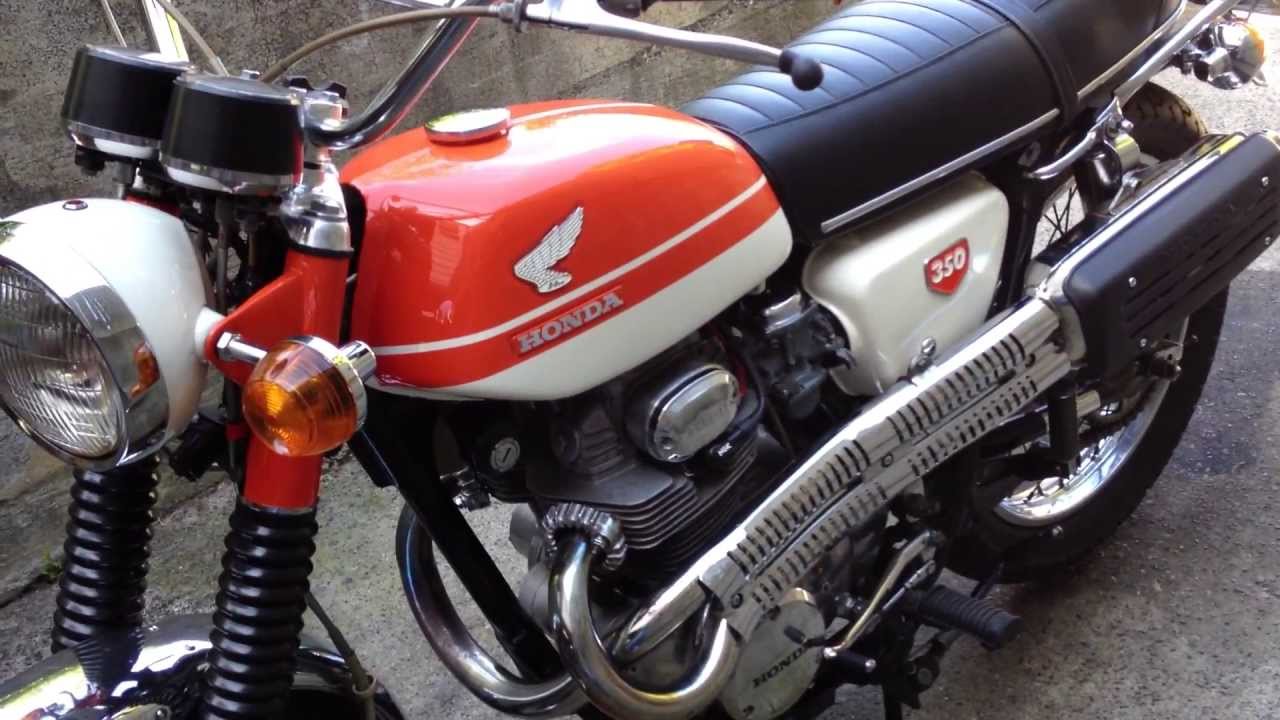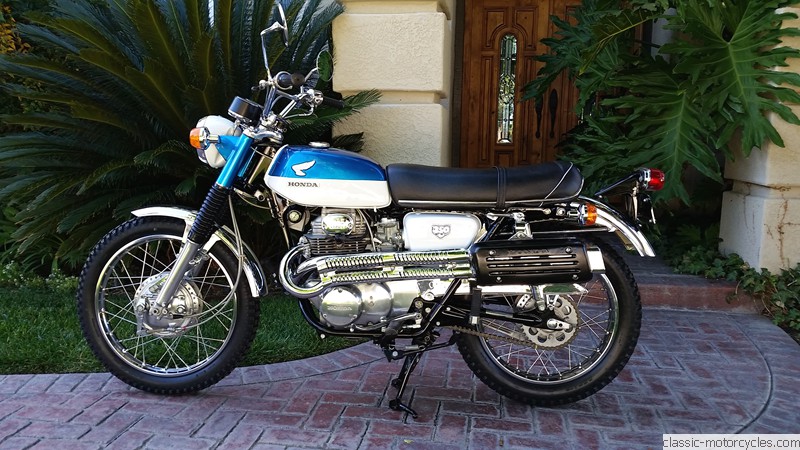Vintage_Mania
1979 Honda CB400T

Honda might not have been the first motorcycle maker to market a high-pipe 2-cylinder scrambler, but it was probably the most successful.
Many manufacturers had traveled down the scrambler-style street-oriented route before Honda, including BSA and Triumph. None of them, though, were as successful as Honda and their CL350 model, and according to Honda restoration guru Charlie O’Hanlon, none of them have the same cachet.
“Honda CL350s are really their own entity,” Charlie says from his shop — aptly named Charlie’s Place — in Los Angeles. “They have a very ‘Japanese’ style, with plenty of class. But they were built to be ridden, they were built to be reliable, and they were built for people to have fun on them.”
Honda broke open the American market for small, rider-friendly motorcycles in 1959 when they established their import business in LA. Prior to Honda, many of the motorcycles being ridden on the streets and in the dirt in the U.S. were heavy American-built V-twins. Lighter British iron was more sporting, but still featured relatively crude production qualities.

Honda’s first production scrambler was the 250cc CL72, first seen in the U.S. in 1962 when Honda dealers and offroad racers Dave Ekins (brother of stunt rider/racer Bud Ekins) and Bill Robertson Jr. rode a pair of CL72s 963 miles in less than 40 hours in a nonstop race against the clock from Tijuana to La Paz. The 250cc scramblers were soon on showroom floors, and they sold well.
For some reason, however, Honda didn’t fully appreciate America’s appetite for hitting the trails — or at least thinking they could hit the trails. It wasn’t until 1965 that Honda introduced the CL77 — a street/trail machine featuring a slightly detuned version of the 305cc twin-cylinder overhead cam engine found in the sporting Super Hawk street bike. Unlike the Super Hawk, which used the engine as a stressed member, the CL77 was given a full cradle frame and increased ground clearance with two high pipes on the left, each with an internal baffle.
If hard core riders wanted a competitive go-fast desert burner, they were left disappointed. Period testers claimed the CL77 was too heavy for such use, and Cycle World referred to the bike as a “gentleman’s scrambler.” That didn’t bother Honda or buyers. Roughly 89,000 CL72s and CL77s were sold between 1962 and 1968. The CL77 was made through 1967, and some of the 1967 versions were sold and titled as 1968 models.

Honda introduced two entirely new models to the range in 1968 with the CB350 Super Sport and CL350 Scrambler. Despite their model designation these are not 350cc, but 324cc. The top end features a generously finned alloy cylinder block, in the middle of which runs an endless chain looping around the crankshaft and cam sprockets. An adjustable, spring-loaded roller tensions the cam chain, and the camshaft runs directly in aluminum end caps in the separate cylinder head cam carrier. Unfortunately, if there is an Achilles’ heel on these models it is the camshaft design, with excessive galling on cam surfaces often found on engines that haven’t received proper oil changes.
Primary drive is via straight-cut double gears in a staggered tooth arrangement (to cut noise) that mesh directly with the clutch basket. In the lower end, four main bearings (three roller bearings and a ball bearing on the drive side) keep the 180-degree crankshaft from having much chance to flex. According to Charlie, the cranks in these 350s from the late 1960s and early 1970s are some of the strongest around and contribute to the legendary status of the models. “Very rarely do the cranks wear out,” Charlie says, adding, “They are overbuilt, and that’s why these bikes last as long as they do.”
Engines in the CB and CL are basically identical in construction detail. The Scrambler, however, has a lower peak power output of 33 horsepower at 9,500rpm compared to the Super Sport’s claimed 36 horsepower at 10,500rpm. The CL’s lower power rating is due to its exhaust system: The high-rise headers might look thick but they are in fact double-walled pipes with a narrower interior tube. Add the CL’s more restrictive muffler and lower peak rpm and you get its slightly lower power output over the CB.

Honda used a mix of pressed steel and round tube to construct the frame for both the CB and CL models, with steel stampings forming the backbone and rear shock upper mounting points and round tube forming the cradle. Less than half of the CL’s 346-pound weight comes from the engine, which weighs 125 pounds. The rest comes from the bike’s heavy-duty cycle parts, with a 19-inch front rim and an 18-inch hoop at the rear, laced to a 7.8-inch double-leading-shoe drum and 7-inch single-leading-shoe drum, respectively.
If the CL77 was considered a gentleman’s scrambler, there wasn’t much offroad pretension in the Honda CL350. In May 1968, the editors of Cycle wrote: “ ... the scrambler isn’t really a scrambler at all, but a street-scrambler, and as such constitutes a compromise between the ideals of two divergent frames of reference. In this case, as in the case of most street scramblers, ‘street’ is emphasized above ‘scrambler’ and doubt arises regarding the bike’s suitability for bashing around rocks and pines. It is naïve to assume that the scrambler is meant to be a scrambler — it’s not.” Honda built the CB and CL350s until 1973, and if you include the SL variants (introduced in 1969 using the CB/CL350 engine but with a different frame and cycle parts designed for more serious offroad chores) the entire series sold some 626,000 examples. That’s no insignificant number of motorcycles. At one time these bikes were literally everywhere, and thousands of young riders got their first taste of powered two-wheel freedom aboard either a CB350 or CL350 Honda.

Jim Basin of San Carlos, Calif., never used his 1969 Honda CL350 as an offroad bike. He bought his CL350 used in the mid-1970s, and he only rode it a couple times each year and put few miles on it. Unfortunately, he kept the CL350 in a garage where he also stored chlorine for his pool, and the Honda slowly disintegrated. As chlorine breaks down it releases corrosive gases, so the aluminum was pitting and everything else was rusting. So the Honda sat, and then Jim was given a 1992 Yamaha Radian with 1,200 miles on the clock. He decided two bikes was one too many, so he offered the rusting CL350 to a friend, Vincenzo Lo Grosso.
Vincenzo has always had a bike, starting with a small Motobi in Italy. Over the years he’s owned Lambrettas, Vespas and a few Harley-Davidsons, but he was without a bike when Jim gave him the CL350. “I thought maybe I’d clean it up a little and ride it,” Vincenzo says. He soon discovered the CL350 was in desperate need of repair, and that’s when he took it to Charlie.
“It was in terrible condition,” Charlie affirms, “and I figured it would take a certain amount of time to get it back together. It took longer than I thought because as time went by it became more complex, not much was reusable, and at every turn something was fighting me.” For some 20 years Charlie’s Place was located in San Francisco, but he recently moved his shop to LA and changed how he operates the business. He no longer maintains regular shop hours, preferring customers come by appointment only. “Now I can truly focus on one job at a time,” he says.

As with any other complete rebuild Charlie undertakes, the Honda CL350 was totally dismantled, and he removed every nut and bolt and split the crankcases. Charlie assesses parts wear as he strips a machine, making notes of what will need either repair or replacement, and this Honda needed a lot.
Charlie found evidence the CL350 engine had been burning oil, and all the top end components, including valves, guides and springs, were replaced. The camshaft and followers were worn, so Charlie had them resurfaced by Megacycle Cams. The cylinders were bored oversize (+1mm) to clean everything up, and as an added plus, Charlie says the larger displacement gives the engine an extra bit of kick. Charlie cleaned the cases and then had them painted by Pete Misthos of Underground Colors in San Francisco, and replaced every bearing, seal and gasket. New parts also included pistons and rings from Bore Tech, and a new cam chain, cam chain tensioner, oil pump and clutch. The carburetors were completely rebuilt with a mix of new-old-stock Honda components and K&L kits, and Keyster diaphragms.
Pete also restored the seat pan, cutting out rusted metal and patching in fresh material. After painting, Dan Acker of San Francisco stitched a new seat cover. Underground Colors’ Amanda Lynn painted the frame, swingarm and other brackets black, and she also sprayed the blue and white paint on the side covers, gas tank and headlight ears. Unique to the 1969 CL350 is the front fender with its lone reflector — later models have a reflector each side of the headlight ears. Another distinctive feature of all 1969 Honda models, according to Charlie, is a small number “8” on the head of almost every bolt, with only a couple of exceptions. Charlie has a personal supply of freshly plated fasteners.

Charlie chromed good, straight, used rims, and he rebuilt the wheels with fresh spokes. First, though, machinist Dave McClellan in San Francisco turned the brake drum surfaces, and the hubs were polished and reassembled with new bearings and brake shoes. The wheels were completed with a Dunlop K70 tire up front and K81 out back. Modern technology includes an electronic ignition, a new regulator and rectifier, and upgraded coils. Charlie also installed Hagon shocks. “If Honda had had this technology when they were building the bikes, they’d have used it,” Charlie says. “I’m enhancing the bike, and I don’t see it as sacrilege.”
Some sources claim differences between 1968 and 1969 Honda CL350s include a bigger gas tank with a blue stripe breaking up the white surrounding the Honda badge, and a pleated seat top. For those concerned about authenticity, Charlie has this to say: “There is very little purity with older Hondas of this era. Changes were made mid-year in 1969, and many bikes in that window have ‘early’ and ‘late’ features. Vincenzo’s bike is a 1969 with a lot of 1968 features. It is correct. People who claim otherwise are not truly familiar with the bikes. Ask anybody who worked at a dealership during that time, and they will tell you that bikes showed up with different features, and the dealers often changed parts to suit the buyer.”
It doesn’t matter a bit to Vincenzo; the finished Honda CL350 met his expectations. “I don’t ride as hard as I used to,” Vincenzo says, “but I do push the CL350 when I can, and it’s fun to ride. I really like going down the street with everyone giving me the thumbs up. It’s just a beautiful bike. It’s like brand new.” Vincenzo loves it, and at the end of the day, that’s all that really matters.






